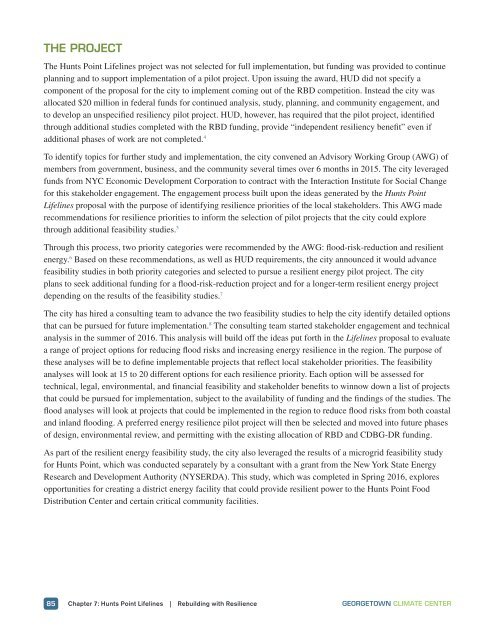Rebuilding with Resilience
dw0r306aHfX
dw0r306aHfX
Create successful ePaper yourself
Turn your PDF publications into a flip-book with our unique Google optimized e-Paper software.
THE PROJECT<br />
The Hunts Point Lifelines project was not selected for full implementation, but funding was provided to continue<br />
planning and to support implementation of a pilot project. Upon issuing the award, HUD did not specify a<br />
component of the proposal for the city to implement coming out of the RBD competition. Instead the city was<br />
allocated $20 million in federal funds for continued analysis, study, planning, and community engagement, and<br />
to develop an unspecified resiliency pilot project. HUD, however, has required that the pilot project, identified<br />
through additional studies completed <strong>with</strong> the RBD funding, provide “independent resiliency benefit” even if<br />
additional phases of work are not completed. 4<br />
To identify topics for further study and implementation, the city convened an Advisory Working Group (AWG) of<br />
members from government, business, and the community several times over 6 months in 2015. The city leveraged<br />
funds from NYC Economic Development Corporation to contract <strong>with</strong> the Interaction Institute for Social Change<br />
for this stakeholder engagement. The engagement process built upon the ideas generated by the Hunts Point<br />
Lifelines proposal <strong>with</strong> the purpose of identifying resilience priorities of the local stakeholders. This AWG made<br />
recommendations for resilience priorities to inform the selection of pilot projects that the city could explore<br />
through additional feasibility studies. 5<br />
Through this process, two priority categories were recommended by the AWG: flood-risk-reduction and resilient<br />
energy. 6 Based on these recommendations, as well as HUD requirements, the city announced it would advance<br />
feasibility studies in both priority categories and selected to pursue a resilient energy pilot project. The city<br />
plans to seek additional funding for a flood-risk-reduction project and for a longer-term resilient energy project<br />
depending on the results of the feasibility studies. 7<br />
The city has hired a consulting team to advance the two feasibility studies to help the city identify detailed options<br />
that can be pursued for future implementation. 8 The consulting team started stakeholder engagement and technical<br />
analysis in the summer of 2016. This analysis will build off the ideas put forth in the Lifelines proposal to evaluate<br />
a range of project options for reducing flood risks and increasing energy resilience in the region. The purpose of<br />
these analyses will be to define implementable projects that reflect local stakeholder priorities. The feasibility<br />
analyses will look at 15 to 20 different options for each resilience priority. Each option will be assessed for<br />
technical, legal, environmental, and financial feasibility and stakeholder benefits to winnow down a list of projects<br />
that could be pursued for implementation, subject to the availability of funding and the findings of the studies. The<br />
flood analyses will look at projects that could be implemented in the region to reduce flood risks from both coastal<br />
and inland flooding. A preferred energy resilience pilot project will then be selected and moved into future phases<br />
of design, environmental review, and permitting <strong>with</strong> the existing allocation of RBD and CDBG-DR funding.<br />
As part of the resilient energy feasibility study, the city also leveraged the results of a microgrid feasibility study<br />
for Hunts Point, which was conducted separately by a consultant <strong>with</strong> a grant from the New York State Energy<br />
Research and Development Authority (NYSERDA). This study, which was completed in Spring 2016, explores<br />
opportunities for creating a district energy facility that could provide resilient power to the Hunts Point Food<br />
Distribution Center and certain critical community facilities.<br />
85 Chapter 7: Hunts Point Lifelines | <strong>Rebuilding</strong> <strong>with</strong> <strong>Resilience</strong> GEORGETOWN CLIMATE CENTER


